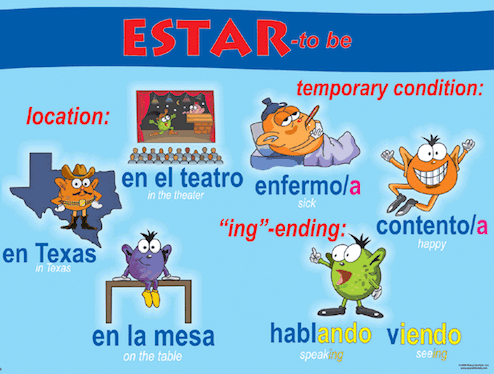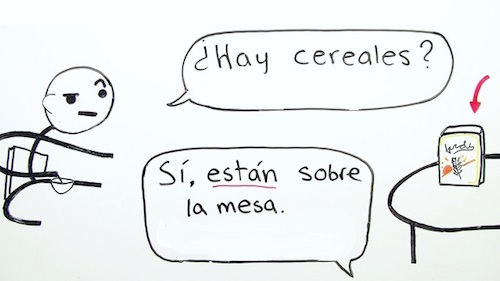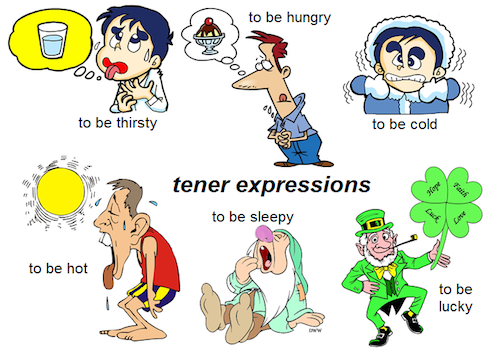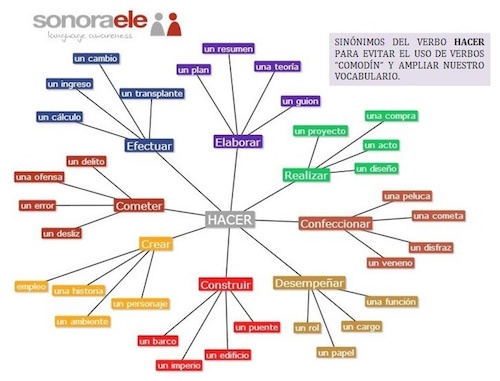Spanish is a beautiful language that seems to have the perfect, lovely sounding words to describe any idea like poetry. But that means there’s a lot of nuance to the language, especially when it comes to verbs, and learning to navigate their particularities can get new students down. While it seems daunting, if you focus on mastering a a few unique Spanish verbs at a time, you’ll get the hang of it faster than you think.
Ser, estar, haber, hacer and tener are five of the most frequently used verbs, they’re a great place to start. Since they all can be used in situations where “to be” or “to become” is used in English, they’re usually confusing for students. By breaking them down to their core elements, understanding them becomes much more digestible and much less intimidating. Because the most important element of learning a language is actually using it, we’ve included a few exercises to get you practicing right away.
Ser
Ser means to be, but is used to describe only permanent ways of being—like whether or not you consider yourself male or female—and it’s conjugated like this:
- (yo) soy — I am
- (tu) eres — you (singular) are
- (el, ella, usted) es — he / she / you (polite singular) / it is
- (nosotros) somos — we are
- (vosotros) sois — you (two or more people) are (only used in Spain)
- (ellos, ellas, ustedes) son — they / you (polite plural) are
The permanent states of being that ser is used to describe have to do with origin (Mis primos son de Bergen — My cousins are from Bergen), identification (Juan es dentista — Juan is a dentist), characteristics (Tu eres alto y moreno — You are tall and brunette), time and day (Mañana es sábado — Tomorrow is Saturday), and property and material descriptions (El libro es de María — The book is María’s).
Now that you’ve got the general guidelines for using ser, let’s take a look at some specific cases in which ser is always used.
1. Describing permanent traits such as:
- Colors: La casa es blanca — The house is white.
- Sizes: El carro es grande — The car is big.
- Professions: Soy profesora — I am a professor.
- Times: Son las dos y media — It is 2:30.
- Dates: Es el 2 de mayo — It is May 2nd.
- Nationalities: Es alemán — It is Germaná
- Personalities: Pedro es simpático y guapo — Pedro is nice and handsome.
- Materials: La blusa es de seda — The blouse is silk.
- Facts: Madrid es la capital de España — Madrid is the capital of Spain.
2. Using the passive voice.
When using the passive voice, ser is the auxiliary verb. In the following example, ser is used with construir to talk about when the house was built:
- La casa fue construida por sus padres — The house was built by her/his parents.
3. When expressing emphasis.
- Es el domingo cuando vamos a viajar — Sunday is when we are going to travel.
Estar
Estar means “to be” as well, but it’s used in many of the cases when ser isn’t and is conjugated like this:
- (yo) estoy — I am
- (tu) estás — you (singular) are
- (el, ella, usted) está — he / she / you (polite singular form) / it is
- (nosotros) estamos — we are
- (vosotros) estáis — you (two or more people) are (only used in Spain)
- (ellos, ellas, ustedes) están — they / you (polite form in plural) are
Estar is always used in three different situations:
1. Describing states of being that are related to temporary conditions like feelings, state of mind, health.
- ¿Cómo estás? — How are you?
- Estoy feliz — I am happy.
- Estoy mal/enferma — I feel sick.
- Estoy enojado — I am angry.
2. Describing location.
- Nicaragua está en centroamérica — Nicaragua is in Central America.
3. Creating the gerund conjugation (-ing in English) when expressing actions happening right now; estar is the auxiliary verb.
- Estamos comiendo pizza — We are eating pizza.
4. Regarding current location.
- Mis libros están en casa — My books are at home.
5. Expressing personal opinions.
- El pescado está muy bueno — The fish is very good.
Because most non-Spanish speakers (like English speakers, for example) don’t have two different verbs for “to be,” distinguishing between them can be difficult. If you need a refresher about understanding when to use ser and when to use estar, don’t worry. We’ve got a whole post on that right here complete with an exercise for practice too!
Haber
Haber is an indefinite verb that loosely means to exist or to be, but is used specifically to locate a new object in a present situation or to introduce new phenomenons in a context. In these specific instances, you’ll see it used instead of estar when locating things. If this seems confusing, don’t worry—it’s a difficult thing for non-native Spanish speakers to get their minds around. But don’t worry, you will! And afterwards you’ll likely learn to appreciate just how Latin American this lovely, tricky little verb is.
Ok, let’s get to it. Haber is used to ask whether or not something is available or to describe the presence of something. It’s often used with un or una, muchos or muchas, and numbers. Some examples:
- ¿Hay una farmácia por aquí? — Is there a pharmacy around here?
- Hay muchas personas en la calle — There are a lot of persons in the street.
- Hay cuatro sillas en mi sala — There are four chairs in my living room.
One interesting thing to remember about haber that actually makes it easier to use is that it only has one form in each of the three tenses in which it’s used (the present tense and two of the past tenses).
- Present: Hay — there is / are
- Past imperfect: Había — there was / were there
- Past preterit: Hubo — there was / were there
Don’t worry about distinguishing between the past tenses just yet. The important thing to know is that there are three tenses in which haber is used and that’s it. (Distinguishing between the past tenses is a whole other can of worms, which is why it’s the subject of our upcoming blog post. Check back in a few weeks!)
While there are two more unique verbs to cover, distinguishing between when to use ser, estar, and haber is a skill to master all on it’s own. Because learning requires practice, here are a couple of interactive exercises to get you started—this one is a bit easier and a good place to start. This exercise is a bit more advanced so you can begin to refine your understanding over time.
Tener
The verb tener means “to have.” It’s irregular and is conjugated like this:
- (yo) tengo — I have
- (tu) tienes — you (singular) have
- (el, ella, usted) tiene — he / she / you (polite singular) / it has
- (nosotros) tenemos — we have
- (vosotros) tenéis — you (two or more people) have (only used in Spain)
- (ellos, ellas, ustedes) tienen — they / you (polite plural) have
In Spanish, tener is often used to express feelings and physical situations that, in English, are expressed with “to be.” Let’s look at five main ways in which Spanish uses tener:
1. Expressing age.
- Tengo 40 años — I am 40 years old.
- ¿Cuántos años tienes? — How old are you?
2. Describing bodily and needs.
- Tengo hambre — I am hungry.
- Tienes sed — You are thirsty.
- Tengo frío — I am cold.
- Tienen calor — They are warm.
3. Explaining ownership of assets or property.
- Pedro tiene una casa — Pedro has a house.
- Tengo dos hijos — I have two children.
- Tengo una computadora — I have a computer.
4. Describing illness.
- Tengo dolor de cabeza — I have a head ache.
- Tengo dolor de estómago — I have stomach ache.
- Tengo dolor de espalda — My back hurts.
5. “Feeling like” doing something.
- Tengo ganas de ir a México — I feel like going to México.
- Tengo ganas de comer — I want to eat.
- Tengo ganas de tomar una cerveza — I want to have a beer.
Now that we’ve added tener into the mix, try this interactive exercise to practice differentiating between tener, ser, estar, and haber all in one.
Hacer
And finally, hacer. In Spanish hacer also means “to do,” but it can be used to express “to make” as well. It’s irregular and is conjugated like this:
- (yo) hago — I have
- (tu) haces — you (singular) have
- (el, ella, usted) hace — he / she / you (polite singular) / it has
- (nosotros) hacemos — we have
- (vosotros) hacéis — you (two or more people) have (only used in Spain)
- (ellos, ellas, ustedes) hacen — they / you (polite plural) have
An important thing to remember about hacer is this: it is not used to construct questions and is never used as an auxiliary verb. In English you might say, “What does he say?” which, in Spanish, is expressed with “¿Qué dice?” which, directly translated, means “what says he?” In situations like these, hacer is never used.
There are a few situations when Spanish uses hacer in place of “to be” in English. In Spanish, when we talk about the weather, either hacer or estar is used. Here are some examples:
- Hace frío — It is cold.
- Está nublado — It is cloudy.
- Hace calor — It is warm.
- Está oscuro — It is dark.
- Hace sol — It is sunny.
- Está lloviendo — It is raining.
- Hace mal tiempo — It is bad weather.
- Está nevando — It is snowing.
- Hace viento — It is windy.
It can be a bit confusing, but looking at the chart below can help you begin to understand some of the instances in which hacer is used.
There you have it, ladies and gents. While this is a lot to digest, sorting these unique Spanish verbs out as early as possible is a key part of building a solid foundation for your Spanish to build upon. If you’ve got questions or are interested in taking classes so you can learn more, get in touch! We’d love to hear from you.
Happy learning!
Ser image via Temas de Gramática, Nivel Superior. Concha Moreno 2001.
Estar image via tes.com.
Haber image via Speak Like Native.
Tener image via Natalie Platon.
Hacer image via Comunidad Todoele.




